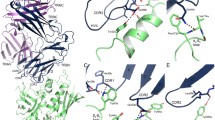Abstract
SEVERAL exoproteins from the bacterium Staphylococcus aureus are highly potent polyclonal activators of T cells in the presence of cells bearing class II antigens of the major histocompatibility complex (MHC)1–3. These toxins, including the toxic shock syndrome toxin (TSST-1), act at nanomolar concentrations, bind directly to class II molecules, and do not require the processing typical of nominal antigen3–7. Each toxin is capable of stimulating a subpopulation of peripheral T lymphocytes bearing particular Vβ sequences as part of their αβ T-cell receptors8,9. It is not known how these so-called 'superantigens' bind to class II and how this binding stimulates T cells. In this study, the different affinities of TSST-1 for human class II molecules DR and DP were exploited to define the region of a class II molecule necessary for high-affinity binding. Using chimaeric α- and β-chains of DR and DP expressed at the surface of transfected murine fibroblasts and a binding assay with TSST-1, it was shown that the α1 domain of DR is essential for high-affinity binding, and further that TSST-1 binding did not prevent subsequent binding of a DR-restricted antigenic peptide. This is compatible with a model of superantigen making external contacts with both class II and T cell receptor, and suggests that the Vβ portion of the T-cell receptor interacts with the nonpolymorphic α-chain of DR.
Similar content being viewed by others
References
Calvano, S. E. et al. Clin. Immun. Immunopath. 33, 99–110 (1984).
Carlsson, R., Fisher, H. & Sjøgren, H. O. J. Immun. 140, 2484–2488 (1988).
Fleischer, B. & Schrezenmeier, H. J. exp. Med. 167, 1697–1707 (1988).
Fischer, H., Dohlsten, M., Lindvall, M., Sjøgren, H. O. & Carlsson, R. J. Immun. 142, 3151–3357 (1989).
Mollick, J. A., Cook, R. G. & Rich, R. R. Science 224, 817–820 (1989).
Scholl, P. R., Diez, A. & Geha, R. S. J. Immun. 143, 2583–2588 (1989).
Fraser, J. D. Nature 339, 221–223 (1989).
Choi, Y. et al. Proc. natn. Acad. Sci. U.S.A. 86, 8941–8945 (1989).
Kappler, J. et al. Science 224, 811–813 (1989).
Scholl, P. R. et al. J. Immun. 144, 226–230 (1990).
Scholl, P. et al. Proc. natn. Acad. Sci. U.S.A. 86, 4210–4214 (1989).
Karp, D. R. et al. J. exp. Med. 171, 615–628 (1990).
Blomster-Hautamaa, D. A., Novick, R. P. & Schlievert, P. M. J. Immun. 137, 3572–3576 (1986).
Edwin, C., Parsonnet, J. & Kass, E. H. J. infect. Dis. 158, 1287–1295 (1988).
Brown, J. H. et al. Nature 332, 845–850 (1988).
Busch, R., Strang, G., Howland, K. & Rothbard, J. B. Int. Immun. 2, 443–451 (1990).
Kavathas, P., Bach, F. H. & DeMars, R. Proc. natn. Acad. Sci. U.S.A. 77, 4251–4255 (1980).
Cole, B. C., Kartchner, D. R. & Wells, D. J. J. Immun. 144, 425–431 (1990).
Berg, L. J., Frank, G. D. & Davis, M. M. Cell 60, 1043–1053 (1990).
Goyert, S. M. & Silver, J. Proc. natn. Acad. Sci. U.S.A. 80, 5719–5723 (1983).
Author information
Authors and Affiliations
Rights and permissions
About this article
Cite this article
Karp, D., Teletski, C., Scholl, P. et al. The α1 domain of the HLA-DR molecule is essential for high-affinity binding of the toxic shock syndrome toxin-1. Nature 346, 474–476 (1990). https://doi.org/10.1038/346474a0
Received:
Accepted:
Issue Date:
DOI: https://doi.org/10.1038/346474a0
- Springer Nature Limited
This article is cited by
-
Increased CD74 binding and EAE treatment efficacy of a modified DRα1 molecular construct
Metabolic Brain Disease (2019)
-
Humanized mice mount specific adaptive and innate immune responses to EBV and TSST-1
Nature Medicine (2006)
-
Evidence for a superantigen in the pathogenesis of tuberculosis
Springer Seminars in Immunopathology (1996)
-
The Role of superantigens in virus infection
Journal of Clinical Immunology (1995)
-
Three-dimensional structure of a human class II histocompatibility molecule complexed with superantigen
Nature (1994)





